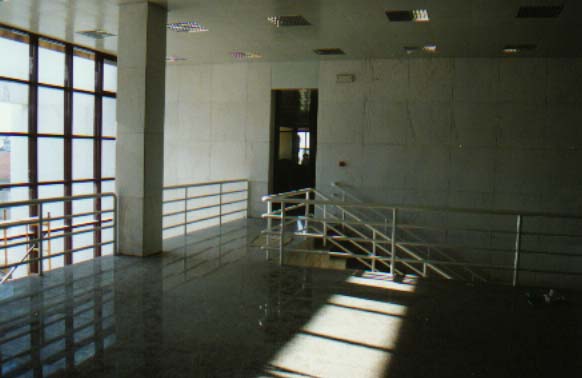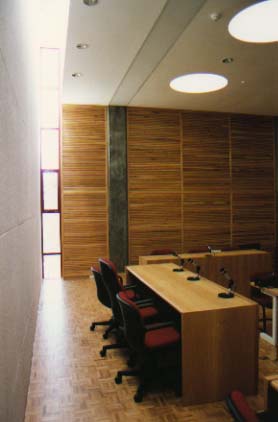The concern of designing a building according to the magnitude of the activities carried out and their respective social impact drove us to adopt a solution that is characterized by some austerity, which we plan to achieve through simple shapes, enhanced and livened up by a clear-dark provided by a projections and indentations’ set.
A metric, both downright and horizontal, guides the entire composition, integrating all the elements that incorporate the facades composition, such as the different elements volumes’ definition and the proportion and positioning, both of windows and doors.
According to this concept, the main lobby, without evading the regulator metric, presents itself as a back large glazed vain, with a height that corresponds to the building’s two floors, which anticipates the public hall’s presence in the ground and first floor. A large porch, developing alongside to the main façade and contributing to its characterization as such, adds some desirable monumentality to the set.
The white stone option, being the only covering material of the façade’s embroidery, besides composing a solution that guarantees a permanent good appearance, contributes to the desired reinforcement of the said dignity sensation.
The same criterion is extended to the building’s interior, with particular incidence in the two halls, whose link with the exterior is considered relevant.
This important room, on account of its functions on the one hand, and for its proportions and characteristics on the other hand, must be the building’s most important aspect, which obviously led to a special attention in what concerns to its treatment.
The disposition and positioning of the different parties present in the court’s sessions, follow a strictly the defined program.
The choice, location and shape of the covering materials deserved special attention, on account of the intention that they, not only provided a good resistance to the use and durability, but also would contribute to the room’s necessary dignity. In accordance to this regulation and taking into account the features related with good’s acoustics conditions, the option was to use noble woods and marbles.
The natural lighting question was solved by using zenithal lighting. For the room, in general, the light bursts from a set of skylights incorporated in dispersion cones topped by translucent covers of diffuser material; in the suspended ceiling, other elements, also translucent and diffusing, provide equable room lighting. The presidency receives a greater amount of light, in comparison to the rest of the room, given a certain device, similar to the others, with a straight shape, developing along the background wall’s length, whose lightning is enhanced by the light provided by the side windows, slim and with a great downright development. Thus, it was ensured that the most important room area has an enhanced lighting, without, however, occurring any dazzle phenomena.
Owner:
Ministério da Justiça
Location:
Mação
Santarém district
Construction Area:
1.800m²
Project:
1991
Conclusion:
1993
Program:
Building intended for the Judicial Court, Civil Registry, Estate Registry and Notary facilities.
Team:
Architecture
– Manuel Cottinelli Telmo Pardal Monteiro – Architect
– João Cottinelli Telmo Pardal Monteiro – Architect
– António Pedro Batista Pardal Monteiro – Architect
– Amadeu Lourenço
– João Sobral Otero
– Rodrigo Moutinho
Foundations and Structure
– Paulo Reis – Engineer
Mechanical Equipment and Facilities
– Marobal
Water and Sewage Equipment and Facilities
– Carlos Palma – Engineer
Electrical and Telecommunications Equipment and Facilities
– Marobal





